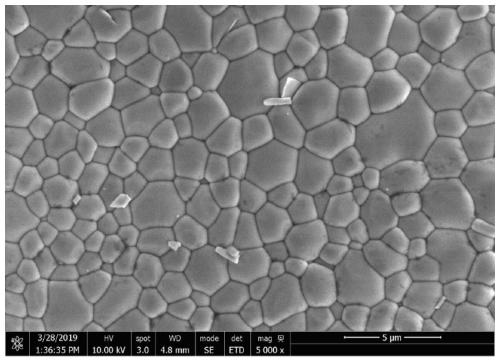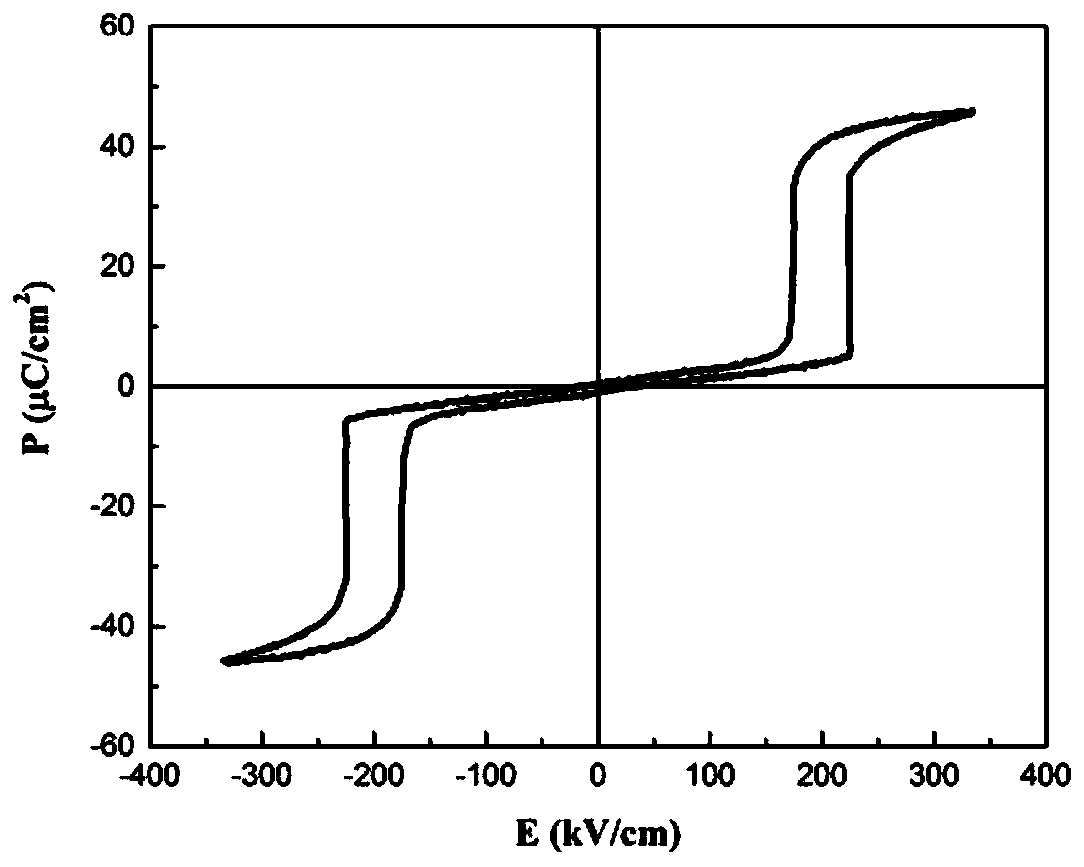PbHfO3-based anti-ferroelectric material based on film rolling process, preparation method and applications thereof
An antiferroelectric and hafnium acid technology, applied in circuits, capacitors, electrical components, etc., can solve the problems of high saturation polarization, low breakdown field strength, and poor compactness, so as to improve breakdown resistance and energy storage Density, preparation method is simple and easy, and the effect of good application value
- Summary
- Abstract
- Description
- Claims
- Application Information
AI Technical Summary
Problems solved by technology
Method used
Image
Examples
Embodiment 1
[0033] Use the purity of analytically pure PbO, HfO 2 , according to PbHfO 3 The stoichiometric ratio of Pb and Hf in the mixture is weighed and batched, and the prepared material is put into a ball mill tank, and the ratio of ball to material to medium is 2:1:1. The ball milling time is 24 hours. After ball milling, take it out and dry it, pre-burn it at 850°C for 2 hours, then ball mill it again for 12 hours, dry it and sieve it. Then add 25% binder, firstly rough roll repeatedly for 1 hour on the film rolling machine, and finally finish roll to 0.26mm, and cut into green sheets of 10mm*10mm. Finally, place the debonded biscuit in a closed aluminum oxide dry pot, and place a thin aluminum oxide plate on top of the sample to avoid bending, and sprinkle an appropriate amount of lead oxide powder around it to avoid the loss of lead. Put the alumina crucible containing the biscuit into the muffle furnace, debond at 600°C for 4 hours, the heating rate is 1°C per minute, and the...
Embodiment 2
[0035] The purity is analytically pure PbO, La 2 o 3 , HfO 2 , SnO 2 According to (Pb 0.97 La 0.02 )(Hf 0.45 sn 0.55 ) 0.995 o 3 The stoichiometric ratio of Pb, La, Hf and Sn in the medium is weighed and batched, and the prepared materials are put into the ball mill tank, and the ratio of ball to material to medium is 2:1:1. The ball milling time is 24 hours. After ball milling, take it out and dry it, pre-burn it at 850°C for 2 hours, then ball mill it again for 12 hours, dry it and sieve it. Then add 25% binder, firstly rough roll repeatedly for 1 hour on the film rolling machine, and finally finish roll to 0.26mm, and cut into green sheets of 10mm*10mm. Finally, place the debonded biscuit in a closed aluminum oxide dry pot, and place a thin aluminum oxide plate on top of the sample to avoid bending, and sprinkle raw materials of the same composition around it to further prevent lead from being exposed to high temperatures. When the volatilization. Put the alumina...
Embodiment 3
[0037] A lead hafnate-based antiferroelectric material based on rolling film technology, with (Pb 0.04 La 0.04 )(Hf 0.26 sn 0.68 Ti 0.06 )O 3 As the substrate, the preparation method is as follows:
[0038] 1) lead oxide, hafnium oxide, lanthanum oxide, tin oxide and titanium oxide according to (Pb 0.04 La 0.04 )(Hf 0.26 sn 0.68 Ti 0.06 )O 3 The corresponding stoichiometric ratio of Pb, Hf, La, Sn, Ti in the mixture is mixed to obtain the mixed material, and a ball milling process is carried out in a ball mill tank;
[0039] 2) Dry the primary ground material at 130°C, and keep the temperature at 850°C for 2 hours for pre-calcination;
[0040] 3) The pre-calcined material is first crushed by a mortar, and then ball milled for a second time in a ball mill tank, and dried at 130°C;
[0041] 4) Mix the dried material with the binder at a mass ratio of 0.2:1, firstly carry out rough rolling on a film rolling machine for 1 hour, then finish rolling to the required thick...
PUM
| Property | Measurement | Unit |
|---|---|---|
| breakdown field strength | aaaaa | aaaaa |
| energy density | aaaaa | aaaaa |
Abstract
Description
Claims
Application Information
 Login to View More
Login to View More - R&D
- Intellectual Property
- Life Sciences
- Materials
- Tech Scout
- Unparalleled Data Quality
- Higher Quality Content
- 60% Fewer Hallucinations
Browse by: Latest US Patents, China's latest patents, Technical Efficacy Thesaurus, Application Domain, Technology Topic, Popular Technical Reports.
© 2025 PatSnap. All rights reserved.Legal|Privacy policy|Modern Slavery Act Transparency Statement|Sitemap|About US| Contact US: help@patsnap.com


